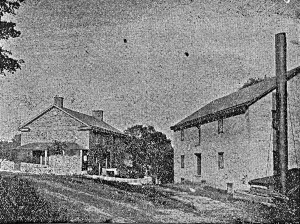by Jonathan M. Hoppock
Democrat-Advertiser, 11 October 1901

This mansion, originally erected by Luther Opdycke, a few years previous to the Revolution, and remodeled by its present owner, Mr. Joseph Carrell, was for a short time occupied by the Commander-in-Chief, General George Washington, as his headquarters in the month of July, 1777, this being the time a portion of his army was encamped on the farm upon which the buildings are situated.1 A part of the army made a three days’ encampment at this place, the other portions encamping on the farms of H. M. Holcombe and Nathaniel Shepherd, near Sand Brook.2
On breaking camp at these points, the division on the Holcombe farm left the Township by way of the Trenton road, on their march to the defense of Philadelphia, striking the Delaware at Trenton; the division on the Shepherd farm went by way of the road leading from Flemington to Stockton, then known as Howell’s Ferry. This road at that time was known as the “old Indian trail, leading from the Raritan to the Delaware. The part of the army on the Carrell property passed by way of Mount Airy, from that place taking the old York road to Lambertville then called Coryell’s Ferry.3
Numerous incidents in reference to the army during its stop at this point are still kept in memory by tradition. This part of the State at that time was, of course, but thinly populated, but the people, almost to a man, were in hearty sympathy with the patriotic cause.4 Numerous recruits were added to their numbers while remaining here. The citizens did all that lay in their power to relieve the sufferings of the soldiers, gratuitously furnishing food and clothing, and in many other ways administering to their wants.
To us living at the present, what a satisfaction is given when memory reflects on this part of the history of our grand old country! Contributing as it did, as much, or more, in men and means, than any other section of the old Thirteen, of equal population and wealth, its aid to the patriotic cause was no mean factor in bringing to a successful termination the long and bloody struggle for American independence. The memory of the deeds of the sires of ’76 cannot be held in too great a veneration by their descendants living in 1901.
Note: The photograph above was taken of the picture included with this article as it was published in the Democrat-Advertiser, original copies of which can be found at the Hunterdon County Historical Society. This explains its poor quality.
- First of all, the house was built by John Opdycke, not his nephew Luther Opdycke, who lived in Alexandria Township. Secondly, the house at Headquarters that Hoppock is writing about was the mansion house on the mill lot, owned and occupied during the Revolution by Benjamin and Elizabeth Tyson. The Opdycke family claimed that Tyson was a Tory. If that is true, it is very unlikely that Washington would be spending time there. John Opdycke was living on a farm south of the mill property, on Lambertville-Headquarters Road. ↩
- The encampment Hoppock refers to has never been documented by students of the Revolution or of George Washington’s life. The only time Washington could have come near Headquarters was on July 28, 1777. As I’ve written elsewhere, Washington wrote a letter from a place 4 miles east of Flemington on the 28th, and was in Coryell’s Ferry on the 29th. A 3-day’s encampment does not fit that schedule, although Washington could have moved on to Coryell’s Ferry before the army did. Hiram Moore Holcombe owned the old Kitchen Mill property on Brittain Road, and Nathaniel Shepherd’s farm was on the west side of Route 523, south of Sand Brook, which once belonged to J. M. Hoppock’s ancestor, John Hoppock. ↩
- If Hoppock is right about the encampments, then the routes he describes all make perfect sense. ↩
- That is not true. There were Loyalists in the area, as well as patriots. One member of the Amwell militia, Cornelius Myers, wrote in his pension application that he had to come home because neighborhood “Tories” had driven off his cattle. ↩